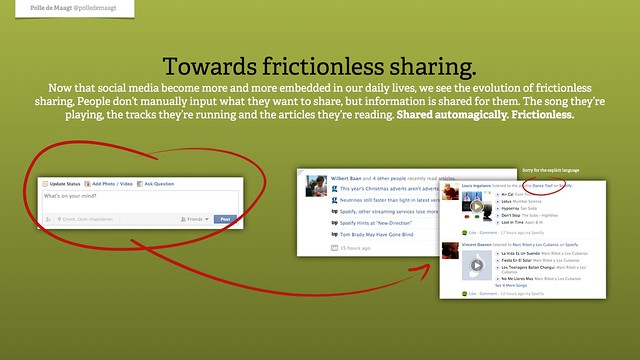A follow up on yesterday’s article on the sharing bias, while some were confused by the concept of frictionless sharing. It has been more than a month since Facebook introduced frictionless sharing. Frictionless sharing lets apps from services like Spotify and publishers like the Washington Post post a user’s activity to their wall, without asking for permission for every item.
Every song you play in Spotify.
Every article you read on the Washington Post website.
And possibly
Every mile you run with Nike+.
Everything you buy at Wallmart, Delhaize, Jumbo or Albert Heijn.
And we’re in for quite some more. Facebook Beacon might have been a bit too early, but Mark Zuckerberg’s “law of social sharing”, that the amount of data people share doubles every year, seems to hold. More photos, tweets, tumblr posts, videos, check-ins, updates and shares than ever.
Not so long ago (in 2006), Facebook users revolted when the news feed was introduced. Many users felt uncomfortable with the idea that their activity on Facebook (likes, comments) would be broadcast to other Facebook users all the time. But look where we are now. So, regardless of what people say they will do, or how much they criticize features like frictionless sharing from social apps, they will eventually use it. The idea that apps are sharing a continuous stream of our activity will seem just as commonplace and uncontroversial as the original news feed.
So, what is the next content we will share frictionless? How long until we will frictionless share our medical data?
And how will this frictionless sharing change our behavior? Frictionless sharing is the basis for playlitism and the sharing bias: when you consciously share content, you’re tempted to tweak it to appeal to your peers. What’s next?
More frictionless sharing? Both ReadWriteWeb and GigaOm ran insightfull posts on the introduction of frictionless sharing.

1 comment
Nice addition to yesterday’s post Polle. Interesting stuff